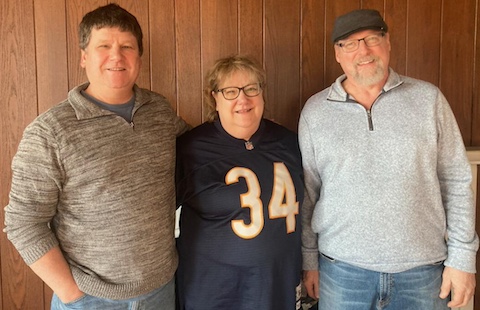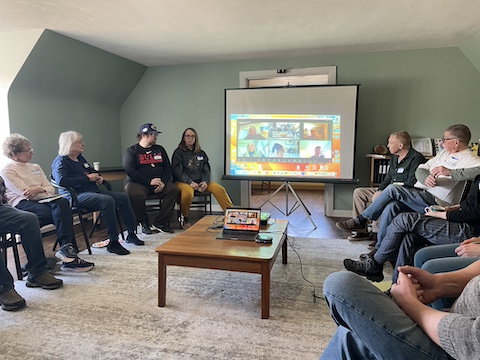Twenty-four readers including some very special guests participated in a Friends of the Fox River (FOTFR) first: hosting a group read and community discussion about the book Raising Kane, the autobiography of a local teacher known as The Fox. So what does that mean exactly? Was a book written from the perspective of the fox, the animal? Or surely, the personification of the Fox, the river? Or, is the Fox actually a human? Well, all three come into play.
Here’s the backstory on the local legend, The Fox
It was late in the 1960s and industrial pollution was rampant and unregulated. Picture pipes spewing toxic liquids, clouds of black smoke and resulting ash residue, and untreated sewage floating down waterways. Our Fox River Valley was no exception to these events.
It was all too much on the psyche of one biology teacher from Montgomery, IL, especially when he found a mother duck and her ducklings floating dead in a Fox River tributary near the outfall pipe of a soap manufacturing plant. Remembering an equally powerful, but opposite encounter with a fox he had locked eyes with recently, the teacher, overtaken by his compassion for the natural world, decided it was time to take action. Bureaucratic solutions to pollution prevention had a proven track record of ineffectiveness, so Jim Phillips the biology teacher took on a new persona, becoming known as “The Fox,” executing what he called “capers” in which polluters received a costly (and often smelly) message about the harm their waste was doing. The Fox would plug waste outlet pipes, backing up liquid or smoke into the factories that were releasing it into the environment. His actions were always non-violent and his message was always clear: stop polluting and the retaliation will stop. Messaging campaigns via giant signs, posters, and stickers on products manufactured by polluters brought public exposure to the environmental harm. After 30 years of activism, hundreds of “kindred spirits” supported his work and are inspired by him to this day.
“It was against the law to obviously dump sewage into the river, the problem was there was no authority to take care of it.”
— Rob Phillips, nephew of The Fox
Raising Kane Group Read on February 11th
Earlier this month, a cohort of kindred spirits visited the Friends of the Fox River at the Schweitzer Environmental Center for lively conversation about Raising Kane, The Fox himself, and what Fox River protection looks like today. The group was a high-minded assemblage of Fox River watershed residents including FOTFR Board and staff members, teachers, government officials, and ecologists. The networking power of social media also connected FOTFR to Jim Spring, nephew of The Fox, who attended along with his sister Nancy Spring-Epley and their cousin Rob Phillips. The Fox did not have children of his own, so these individuals were among his closest kin. The family delighted the group by sharing stories about their respective roles as accomplices during Fox’s capers. The embellishments were the best part, like when we all heard about the state of disrepair of Fox’s car, despite its crucial role as the getaway vehicle.

Jim Phillips a.k.a. The Fox.
Fox River Protection 1960s vs. 2020s
The tone of the day’s conversation undulated between lighthearted story-telling and serious calls to action. Readers agreed that Fox River protection has changed since the era of The Fox’s capers. Water pollution doesn’t always look like a pipe emptying terrible looking water, or a villain dumping a barrel of oil into the river. In fact, since the passage of the Clean Water Act of 1972, industrial and municipal waste, known as point source pollution, has been highly regulated and the river has massively recovered. What is not regulated, however, is the pollution that makes its way into waterways from our developed landscapes through runoff or storm drains. Its source, composition, and concentration is far more difficult to characterize. Pollution of this nature is known as nonpoint source pollution.
Vice President of the Friends of the Fox River Doug Williamson had this to say when comparing today’s pollution problems to those that The Fox was illuminating for the public:
“It’s all of us. We’re the nonpoint source polluters. The awareness of what’s going on has not moved in the same direction.”
Batavia resident Beryl MacLaughlan chimed in to say, “With these nonpoint source polluters it’s harder to know where to direct that poetic justice.”
Education for Environmental Action
As though we were writing a composition on Fox River protection, our discussion drew from historical examples, identified current problems, then transitioned seamlessly into discussing solutions. Where we landed was education. The expertise of the teachers in the room, active or retired, was invaluable.
“Kids need to be outside,” middle school science teacher Holly Yee stated matter-of-factly. Retired middle school science teacher Nancy Spring-Epley and 4th grade teacher Katelynn Ambrosini agree. Nancy shared how noticeable the reduction of time spent outdoors was for her 8th grade students over the years. Katelynn made us feel hopeful again wearing her heart on her sleeve telling us a story about a child that struggled in many aspects while inside the building, but lit up when he proudly pointed out the native flowers that he had planted while walking in front of the school with his peers.
“The change has to be in our culture, a culture of care”
Jim Spring
What’s Next for the Fox River?
The challenges the river faces today are tied directly to a lack of awareness of the impact of our cultural tendencies. The daily work of the Friends of the Fox River is to face this knowledge gap by providing opportunities to learn about these impacts and connect with the natural world. FOTFR leadership consists of a large faction of retired professional educators and the organization’s biggest investment is in its full time staff position that is devoted to education. FOTFR reaches 5000 learners annually, both youth and adult. FOTFR collaborates with dozens of agencies that provide outreach opportunities about contemporary green infrastructure planning, agricultural best practices, and water quality policy.
To honor the legacy of The Fox, FOTFR will continue to be the voice of the Fox River. Our first Group Read of Raising Kane and community discussion was a powerful reminder that we are stronger together. The last quotable quote comes from Cynthia Kanner, long-time Friend of the Fox River and executive director of partner organization the Prairie State Conservation Coalition. She said, “[The Fox] inspired a lot of people to realize that they have a voice and can be advocates and that they have a role to play in the health of the Fox River. I feel hopeful because of all the thousands of young people that this organization reaches.” Bingo Cynthia. GO FOX. Stop pollution.
Send your river protection stories or questions to info@friendsofthefoxriver.org



